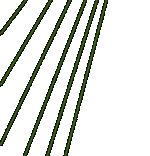Holographic
interferometry
V.B. Yasinsky (yas@holography.ru), S.M.
Zharkiy (oquagen@holography.ru).
Introduction
Holograms have been
coming to every home for last years. Colorful labels on audio and video cassettes,
holographic trade and protective marks, holograms on credit cards and labels for different
products. Many popular magazines have released with the holograms. The large progress in
representational holography has achieved. The exhibitions of holographic copies of museum
rarities are already arranged. Manufacturing of holographic portraits also grows.
Holography have already ceased to be an exotic. However, some holographic applications are
not widely known in modern life. It is a problem of image recognition, interferometry of
measurement, holographic optical elements, questions of image processing and many others.
This publication about
the special holographic application - holographic interferometry.
Of course, holographic
interferometry has appeared not on an empty place. The classical interferometry was
before. Therefore we shall begin from it.
Classical interferometry
The classical
interferometry always have deals only with transparent and a smooth surfaces. It seemed,
that's forever. And destiny of interferometry - studying of gases and liquids, mirrors and
lenses. Certainly, the field of work was wide there. There were also big practical
results.
For example, the mine
interferometers for definition of dangerous methane concentration. How many lives they
have rescued! Due to those small and very reliable devices the word
"interferometer" is well-known in each miner's family. Besides, control at
manufacture of optical products. And the measurement of thickness of very thin coverings
and super exact control (with accuracy of half of wave length) of movement distances. And
express estimation of quality of a surface processing using a special glass plate. What is
another possible way to define (at first sight!) a rough surface deviation of some microns
from the necessary sizes in several seconds?
Certainly, there is and
will be many other applications of interferometry and discoveries, that will made, using
this technique. But, I repeat, we talk only about transparent or smooth objects, which
deform radiation a very little. There is even a concept - "interferometric
accuracy". It means, that the surfaces of optical elements should be processed so
that height of roughnesses did not exceed 0,1 wave length of light.
The invention of a
holography has enabled to carry out interferometric research not only transparent objects,
but also objects which reflected diffused beam. The way of interaction between radiation
and object defines separation of objects: phase (transparent) and diffuse (that is
reflecting, but not mirror).
Holographic interferometry
What is exactly the new
that holography has brought in usual interferometry? At the beginning let's say:
Holography is the
method of recording and reconstruction of the total optical information from the
object.
If so, and the wave,
restored from the hologram, completely corresponds to the object at recording, hence, this
wave can be investigated by the same optical methods, as the object. It is possible to
carry out shadow, shliren and interferometric measurement. If we also record polarizing
characteristics (such ways exist), the opportunities of reception of the information will
increase.
In practice it means:
if we have the hologram it is possible to investigate the object with short life in
details, subsequently by any optical methods, as though the object was static.
There is also used
interferometry, but not holographic. The object could be investigated by interferometric
(or another optical) methods through its holographic copy, like in holography.
Concept
"holographic interferometry" means something absolutely another, using features
of holographic principles of information recording. Let's look, what's this...-->
|





